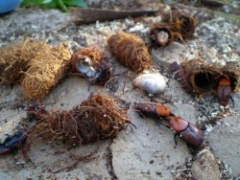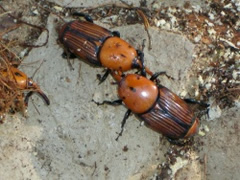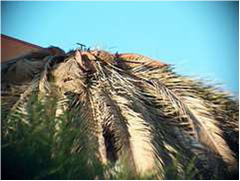 Rhynchophorus ferrugineus – the Red Palm Weevil
Rhynchophorus ferrugineus – the Red Palm Weevil
Big palm trees, imported from Spain and originating from Asia and Africa beautify golf courses, municipal areas, and give private homes an instant Mediterranean look. But they also carry a lethal freight: Rhynchophorus ferrugineus – the Red Palm Weevil.
Damages and losses of palm trees were first reported from Spain in 1994; since then the Weevil has spread, flying or being carried inside an infected palm tree, and has been doing its devastating work in Italy, on the Canary Islands, in France, and since a few years, also in the Algarve.
 The Weevil can reach a size of up to 5cm (2 inches) and feeds on the pulp of the stems of the palm branches. Its favourite host is the Phoenix Canariensis and many infected or already dead specimen can be found in the area of Albufeira, Alvor, Mexilhoeira Grande and Lagos.
The Weevil can reach a size of up to 5cm (2 inches) and feeds on the pulp of the stems of the palm branches. Its favourite host is the Phoenix Canariensis and many infected or already dead specimen can be found in the area of Albufeira, Alvor, Mexilhoeira Grande and Lagos.
It is interesting to know, that the Weevil only infects trunks with a minimum of 5cm (2in) in diameter. If it feels comfortable and safe, and if there is enough food, the Weevil will send out pheromones that will attract even more bugs. The female can place up to 200 eggs (2.6 x 1 mm / 0.1in x 0.04in) in the in the space between the trunk and the leaves or in wounds resulting from cutting green palm branches.
 Damage appearance / signs of infection: Little holes in the trunks of the palm branches, new leaves appear dry and in a couple of weeks the whole crown of the palm will “dry up”, will be brown and the leaves will fall off.
Damage appearance / signs of infection: Little holes in the trunks of the palm branches, new leaves appear dry and in a couple of weeks the whole crown of the palm will “dry up”, will be brown and the leaves will fall off.
How can you save your palm tree? The treatment consists of 3 steps:
1. spraying
2. injections
3. traps
1. With a high pressure pump a systemically working insecticide is sprayed into the centre of the palm tree, where it can flow into the holes made by the larvae entering the trunk and where it will kill the insects being on the outside of the palm.
2. 4 injections of a systemically working insecticide into the trunk will kill the larvae inside the palm tree. Through the palm tree's water system the insecticide will be transported even into the tips of the branches of the palm, which results in an “unpleasant flavour” for the Palm Weevil. The procedure of spraying and injecting has to be repeated after 6 weeks. By then, all larvae living inside the trunk and all beetles living on the palm tree should be killed. To maintain the repellent effect, the palm tree should be sprayed every 8 weeks.
3. In combination with those treatments we recommend the use of a pheromone-trap. It attracts the male beetle so that
a. no more fertilisation can take place
b. you can find out, if there are any Red Weevils in your area.
Everyone is responsible for the health of his palm trees! Help us stop the spreading of the plague Rhynchophorus ferrugineus!
